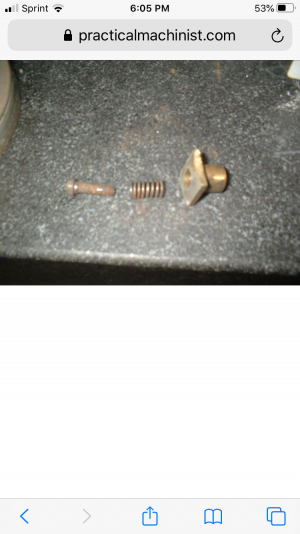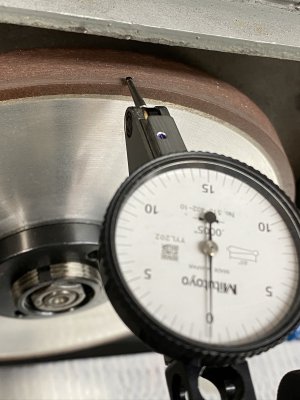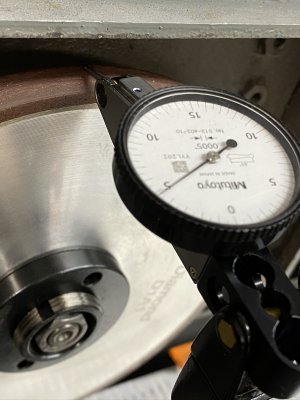-
Welcome back Guest! Did you know you can mentor other members here at H-M? If not, please check out our Relaunch of Hobby Machinist Mentoring Program!
You are using an out of date browser. It may not display this or other websites correctly.
You should upgrade or use an alternative browser.
You should upgrade or use an alternative browser.
Has anyone made a Brake Dresser?
- Thread starter Janderso
- Start date
- Joined
- Aug 3, 2017
- Messages
- 2,437
My thought is this is exactly the same as using a diamond dresser (or a grinding wheel itself). You can get it 'close' to having the entire wheel in contact at once, but that is necessarily not true. For example, as you grind with a surface grinder, the leading edge wears away first, so then the area behind it starts cutting, which is why you're supposed to move the whole wheel off the part when switching directions.Erich,
What I am trying to describe is you want to form the cutting edge to be flat against the entire working edge.
I'm trying to understand your point.
Thanks,
Basically, you count on the bed being parallel to the wheel (since you ground your mag chuck with the wheel!), and use the feed to ensure every part of the diamond wheel is 'engaged' by the high point. That is, you move the table forward and backwards, and the diamond working on the dresser (and vice versa) will eventually make sure you've ground it perfectly parallel to the wheel.
- Joined
- Aug 3, 2017
- Messages
- 2,437
That one looks like a normal dresser! Is there a good reason to not just use the single point? It seems that would be easier/more accurate than any sort of brake dresser you could make.
- Joined
- Mar 26, 2018
- Messages
- 8,407
After watching these videos and seeing the possibilities of doing a very good job by these methods, I am steering my thoughts away from the venture.That one looks like a normal dresser! Is there a good reason to not just use the single point? It seems that would be easier/more accurate than any sort of brake dresser you could make.
Also, I see a few of the old Norton "Brake Controlled Truing Device" on Ebay.
- Joined
- Jul 2, 2014
- Messages
- 7,594
What is easily missed here is that we are trying to dress a diamond wheel with a matrix to a flt a face with nice square corners, and keep them that way. Diamond is the hardest material known. You are not going to ablade it except by microns. Instead, individual grains need to be removed from the matrix, and the diamonds are firmly embedded into the matrix, and protected by hundreds of thousands of more diamonds, all protecting each other from anything getting underneath the diamonds that are highest. The diamond wheel, when used properly, will maintain its geometry quite well, not like ordinary grinding wheels. They WILL ablade slowly by the hardest used grit falling out of the matrix. Letting the corners round over or the face become uneven over its width is a big mistake when using diamond wheels. Whenever at all possible, only use full wheel face cuts, plunge or traverse. Work the highest standing diamonds with every pass. It works. I figured this technique out on my own, and it works well for me. If others know better, please let us all know if there are any long used techniques that are currently being kept a secret. I have done every clever search I could think of, and did not find good information on how to 'properly' dress and maintain resin and rubber bonded diamond wheels.
I e looked into making a brake dresser also. Seems fairly easy acouple of brass shoes with spring pressure that run inside a bore putting drag on the dresser spindle so it does spin as fast as grinding spindle. Haven’t got around to it but still on the list. I have some pics of what the inside looks like. There are three of these shoes configured like this.

for a diamond wheel Ive read of just going over coldrolled steel and I think a cbn you go over a aluminum oxide or Other type of broken wheel?? Idk

for a diamond wheel Ive read of just going over coldrolled steel and I think a cbn you go over a aluminum oxide or Other type of broken wheel?? Idk
- Joined
- Mar 26, 2018
- Messages
- 8,407
That's basically what Steve did in the first video. Like Bob says, slow and easy will eventually get you there.for a diamond wheel Ive read of just going over coldrolled steel and I think a cbn you go over a aluminum oxide or Other type of broken wheel?? Idk
I can see if you are grinding hardened tool steel these diamond/CBN wheels have to be perfect or the finish will be compromised.
Me, I'm just grinding stones=very soft.
I am going to work on truing and dressing this crooked wheel though.
Bob, I checked Shars return policy. Too late and it can't be used.
This single point diamond dresser is to true up CBN and Diamond wheels.
If you read the description in the catalog it explains the process.
- Joined
- Jul 2, 2014
- Messages
- 7,594
And that is why you are looking to make a brake dresser. I am pretty sure a decent one would do the job for you, though no experience here...Bob, I checked Shars return policy. Too late and it can't be used.
- Joined
- Mar 26, 2018
- Messages
- 8,407
Success!
Sort of. I got the wheel trued to about .001”. A far cry from .008”
What I need to do now is get the slant out .
If I run the indicator across the surface, I have a .005” deviation, see pics.
If I leave the indicator in the center and spin the wheel 360 degrees I find less than .001” deviation.
Maybe if I take a .005” shim-feeler gauge and run the wheel across the low carbon steel....
Sort of. I got the wheel trued to about .001”. A far cry from .008”
What I need to do now is get the slant out .
If I run the indicator across the surface, I have a .005” deviation, see pics.
If I leave the indicator in the center and spin the wheel 360 degrees I find less than .001” deviation.
Maybe if I take a .005” shim-feeler gauge and run the wheel across the low carbon steel....



